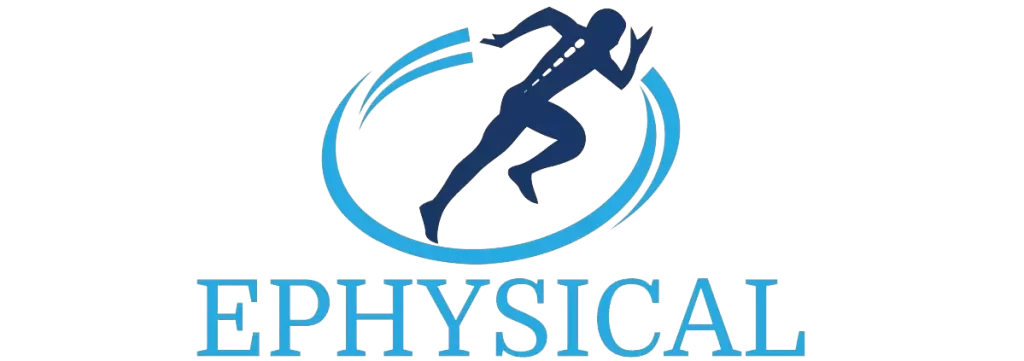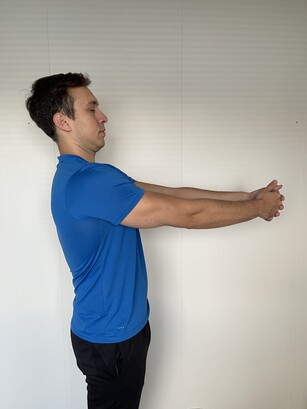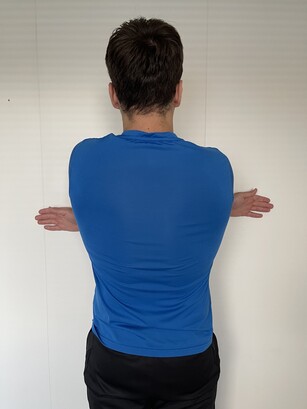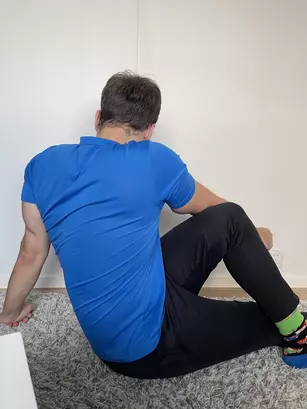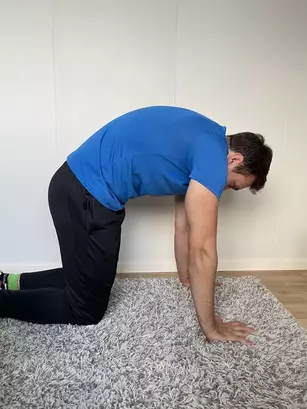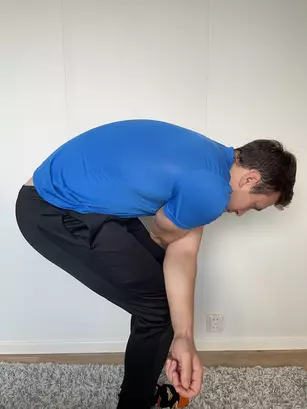How to Stretch Rhomboid Muscle: A Comprehensive Guide to Anatomy, Exercises, and Common Mistakes
Welcome to your one-stop guide for all things related to stretching your rhomboid muscle for pain relief! If you’ve been struggling with that nagging ache between your shoulder blades, you’re not alone.
Rhomboid muscle pain is a common issue, especially among those who spend long hours at a desk or engage in activities that strain the upper back.
In this article you will learn:
- Anatomy and function of rhomboid muscle
- How to stretch rhomboid effectively for pain relief
- Causes and Symptoms of Rhomboid pain
And much more. Let’s dive in!
5 Effective Rhomboid Muscle Pain Stretches
And now, the best stretches for rhomboid muscles you can do even at home, without any stretching equipment.
Shoulder Protraction
Step 1: Stand and cross your fingers. Lift both hands until you reach the shoulder height.
Step 2: Push forward your shoulders, protracting them and placing a gentle stretch on rhomboid muscles. Hold for 30s.
Cross Arm Stretch for Rhomboid
Step 1: Stand facing a wall. With your arms crossed, place both hands flat against the wall. Your hands should be at about head height or slightly lower.
Step 2: Gently lean into the wall, allowing your chest to move towards the wall. You should feel a stretch between your shoulder blades. Hold this position for 30s.
Middle Back Rotation
Step 1: Sit on a floor with straight legs. Then, bend one leg and place the foot on the opposite side (at knee level)
Step 2: Slowly rotate your body to one side, away from the bent knee. Hold this stretch for 30s.
Cat Cow The Rhomboid Version
Step 1: Assume a cat cow stance – hands and knees on the floor with straight back.
Step 2: Lift your middle back up, moving your shoulder blades away from your spine. Hold this position for 30s.
Bent Over Rhomboid Stretch
Step 1: From a standing position, bent over with your upper body and knees. Place crossed arms above your knees.
Step 2: Lean gently forward with your upper body to increase the stretch between your shoulder-blades. Hold this position for 30s.
Anatomy and Function of Rhomboid Muscle
Let’s start first with anatomy of rhomboid muscle.
Location
Situated in the upper back, between the spine and the shoulder blades.
Rhomboid Major: Lower part, attaches from the spinal vertebrae to the medial edge of the scapula.
Rhomboid Minor: Upper part, smaller and sits above the rhomboid major.
Structure
Composed of skeletal muscle fibers.
Innervated by the dorsal scapular nerve.
Attachments
Originates from the spinal vertebrae (C4-T1)
Inserts into the medial border of the scapula.
And now, the function of Rhomboid muscle.
Scapular Retraction
Pulls the shoulder blades towards the spine.
Scapular Elevation
Lifts the shoulder blades upwards.
Scapular Downward Rotation
Rotates the shoulder blades in a downward direction.
Postural Support
Helps maintain an upright posture.
Symptoms and Causes of Rhomboid Muscle Pain
Understanding the symptoms and causes of rhomboid muscle pain is the first step toward effective treatment. Here you can see the most common symptoms of rhomboid pain.
- Aching Pain: A dull, constant ache between the shoulder blades.
- Stiffness: Difficulty in moving the upper back.
- Tightness: A feeling of constriction around the shoulder blades.
- Pinching and Shooting Pain: Sudden, sharp pains.
- Tingling and Numbness: Sensations of pins and needles.
- Muscle Spasms: Sudden, involuntary muscle contractions.
For a more comprehensive understanding, you can refer to WebMD’s article on Rhomboid Muscle Pain.
When to Seek Medical Help
- Persistent pain lasting more than a week.
- Intense pain that disrupts daily activities.
- Symptoms accompanied by chest pain or difficulty breathing.
Let’s see now what are the most common causes of rhomboid muscle pain.
Poor Posture
- Sitting hunched over a computer for extended periods.
Overuse and Repetitive Motions
- Activities like rowing or pulling that repetitively engage the rhomboid muscle.
High-Impact Activities
- Exercises that involve heavy weights and high-impact strains.
Injury
- Direct trauma to the upper back or shoulder area.
Additional Factors
- Thoracic Rotation Issues: Poor mobility in the thoracic region can lead to rhomboid pain.
- Muscle Imbalance: Excess tension in the pectoralis muscles can overload the rhomboid muscles.
Common Mistakes While Stretching Rhomboid Muscles
- Overstretching
- Incorrect form
- Ignoring the pain signals
- Rushing through stretch
- Skipping the warm-up
These are one of the most common stretching mistakes when stretching middle back area, including the rhomboids.
Resources
- Rhomboid Muscle Strain: Rehab Exercises – MyHealth Alberta
- Rhomboid Muscle pain Healthline
- What you Should Know About Rhomboid Pain
Additional Resources
Don’t stop with stretching after you’re done with stretching your rhomboids.
Take a look at my comprehensive guide on stretching – The ebook with 150 pages of pure knowledge to help you achieve the most out of your stretching routine.
The book is called Secrets of Stretching.
